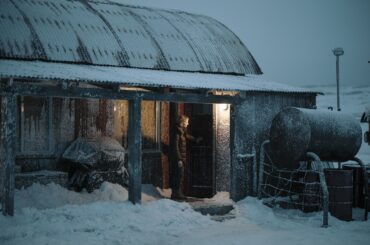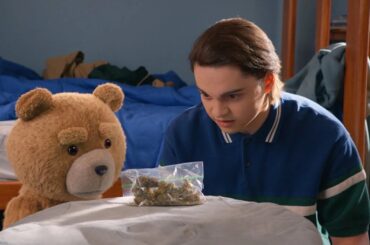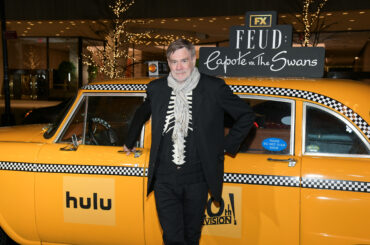Spenser Cohen and Anna Halberg started telling stories together in college. As USC graduates, they founded their own production company, Six-Foot Turkey, while still students. Since their film school days, they’ve worked on a variety of projects, including commercials, music videos, and films. Halberg served as executive producer for films like The Gateway and Expendables 4, while Cohen contributed to the latter’s story and penned the delightfully silly Moonfall.
The creative duo entered Scream Gems Horror Lab years ago and produced a striking horror short, Blink. It led them to writing and directing Tarot for Screen Gems. When the opportunity arrived to make a PG-13 horror movie about friends cursed by a tarot reading, given all the pair’s experience, they were were more than prepared for the challenges.
Recently, Cohen and Halberg spoke with Immersive Media about their feature directorial debut and shared why Jurassic Park means so much to them.
How was your experience in the Screen Gems Horror Lab? What were some lessons you learned from Blink?
Halberg: It was an awesome experience. We had made Blink with Screen Gems and [Tarot producer] Scott Glassgold, and the idea of the incubator program was to make short films that you would then turn into feature films. Even though Tarot isn’t the feature version of Blink, it was a great opportunity for us to get to work with the studio and figure out each other’s sensibilities. We really just saw things the same way.
And so, Sony came to us and had this idea to do a horror movie about astrology. And Spenser and I went away [and discussed]. For us, there wasn’t anything that was inherently super scary about horoscopes and Zodiac signs, but what was really scary for us were tarot cards and tarot readings. We thought of this idea to marry the two together because these disciplines are very related and are often used together, and that’s how this movie came about.
Those tarot cards look great, by the way, and the creatures based on them. Who designed them?
Halberg: We worked super closely with this guy named Trevor Henderson out of Canada, and we had been fans of his for a long time. He’s actually the only person that we approached about designing all of the creatures. We worked really closely with him to make sure that they all felt right, and then we reverse engineered the cards to reflect the characters that Trevor had designed. So our production designer found this incredible artist out of the UK named Richard Wells who helped actually bring the cards to life.
What was some of the trial and error working with your cinematographer about how to best shoot and light the creatures?
Cohen: We did mostly everything practical, and then did some augmentations with VFX, but in order to make the creatures look great, 90% of it is lighting and how it’s lit. So we should give a shout out to our DP, Elie Smolkin (The Final Girls), who helped transform these drawings. And then obviously we had [create effects designer] Dan Martin (Possessor) who created all the prosthetics, but Elie was really the one who put the final touches on it.
The Jester, for example, how’d you both and Elie want to light that character just right?
Cohen: In that sequence in particular, it was the balance between light and dark and wanting to feel like there is something, then something is not there. There’s a couple shots where I feel like you kind of have to squint a little bit and you’re sort of looking to see if he’s actually at the end of the hallway. I think with all of the creatures, and that one in particular, it was just finding that balance between light and dark.
Halberg: I think it’s always scarier what you don’t see and using your imaginations than it is what you do see. We really wanted to hide the creatures until the last possible moment, or when we did show them, make sure that we were showing them in a way that was still scary and felt very eerie.
For the set-pieces, how was working with the PG-13 rating in mind?
Halberg: We knew going in that this was going to be a PG 13 rating, and it was something that we wanted. Spenser and I don’t particularly find blood guts and gore to be that scary. It’s all about the suspense and the tension and the buildup and crafting these sequences and these scares. And so, we spent a lot of time really thinking about unique kills and locations and things that we hadn’t seen in movies before.
Cohen: A movie that we reference all the time is Alien. You don’t really see a lot of the alien in that movie, but your imagination thinks you do, and you fill in those gaps. And so, we find that scarier when we sort of invite the audience in and activate their imaginations. We use sound, we use music, we use everything to make you see something that may or may not be there.
Did you two have any ‘90s horror movie influences for Tarot?
Cohen: I feel like we went more eighties in a lot of our references when we were thinking of things and even a little more modern movies. I think the two sensibilities that we tried to marry was the fun of the ‘80s Spielberg movies with the scares of a James Wan movie. So it was like, can you do Spielberg in the Conjuring in one universe?
I’ve heard you both mention Spielberg a few times. Your production company, Six-Foot Turkey, is a Jurassic Park reference. You two started your company in college, right?
Halberg: We did. We started out working together when we were juniors in college doing music videos and commercials, and we’ve worked together ever since. But Jurassic Park was both my favorite movie and Spenser’s favorite movie. I think it’s the movie that I’ve watched more than any other film. I can probably quote it from beginning to end, and I still don’t get sick of it. It’s just such a fun feel-good entertaining experience. And so, when Spenser and I were thinking of a name for our production company, Six-Foot Turkey is a deep cut Jurassic Park reference, but it just seemed to make sense that it would be from that film.
When you left film school, what were the hopes and dreams? How’s the journey so far compared to what you imagined?
Cohen: It’s all taken a lot longer than we had hoped. I mean, we were doing music videos and commercials. We were being hired while we were in film school with bigger budgets than our shorts at USC. And yeah, when we got out, the reality of the world hits and you’re like, oh, getting a first feature isn’t really that easy.
What Anna and I realized is being poor college kids, we didn’t have all the equipment and we didn’t have access to all the things, but we did have a computer or we had paper and a pencil. So, we started basically directing on the page. For us, writing was everything. That was where we learned our craft. That was where we learned about character, tone, and theme.
Writing was our training ground for ultimately being where we are now. And I do really have this feeling, and I felt it on every project we’ve ever had, but all the breakthroughs really happened in the writing process. And so yeah, getting out of school was just Anna and I sitting in a room and writing nonstop, hoping we could make something work.
Halberg: When you graduate, you’re super eager. It was frustrating a lot of the time that Spenser and I felt like we weren’t getting the breaks that we wanted, but all of the experiences that we had working in production and writing really informed the directing process. I’m so grateful that we had all of those experiences and that we did have to hustle after we graduated, because it helped us to learn a lot.
Now when we’re in pre-production, production, or post, we’ve had to do so many of those jobs that it just helps us to understand where the problems are to help fix issues and to combat a lot of the different obstacles that you come up against when you’re making a movie.
I imagine even producing a Lupe Fiasco music video, something about that gig, as you said, prepared you for Tarot. What were specific moments on the film you were grateful to have that wealth of producing experience for your feature directorial debut?
Cohen: Well, when you’re on all those early things that we did, the music videos and commercials, everything falls apart on those. Your location falls through, the lenses you want aren’t there, and you have to adapt very quickly and think on your feet. And so, I think Anna and I have confidence on set because we know there’s going to be a million problems, and we expect them. We’re waiting for them to come, and when they arrive, we sort of look at each other and we’re like, “Okay, let’s solve this. What do we do?” We expect the problem part of moviemaking to be there.
Halberg: With the scope and scale and size of what we wanted to do, we had a lot of ambition for this movie. Obviously, there are eight monsters, there are a lot of big locations and set pieces, and even though $8 million seems like it’s a lot for a budget, it’s really not when you’re looking at how many things we were trying to pull off and the amount of time we were trying to pull it off. Having the experiences of line producers and producers, and being able to understand schedules and budgets and how a shoot is run, also helped us to make the most of our days, and like I said before, to really combat those obstacles.
What was a day with a lot of technical, practical, or timing issues?
Cohen: One of the trickiest sequences was the sequence on the bridge. It was just because it was hours away from the city. We closed down the bridge, shooting nights, and we had an ambitious shot list that we wanted to pull off. Anna and I and our DP, Elie, we hustled. We had 60 setups planned, and we ended up getting 66. We overperformed. But it was one of those things where we were going into it expecting, I don’t know, this could get really rough…
Halberg: We showed up that day to find our AD being carted away because he had COVID, so he was out for 10 days. We shot that entire sequence without our first AD. Thankfully, our DP is incredible and also helped step in and along with our producer and everybody else. It was a team effort, but we ended up making our days and, like Spenser said, getting a lot of shots.
Anna, how was your experience shooting the tarot reading sequence with all those characters and all the blocking involved?
Halberg: The tarot readings were particularly challenging because you have a lot of information that you need to get across for the movie to pay off, and we need to believe that this is a real group of friends. We need to get to know a lot of different characters, and it’s just a lot to do right upfront. And so, we worked really closely with our DP to maximize our days to make sure that we were shooting in a way that we didn’t have 500 different angles to cover. Ultimately, we ended on the layout that we have, which is the person who’s getting their horoscope, tarot read, and everyone else behind them in a line.
Cohen: And we went back to look at a lot of Spielberg movies, even Jurassic Park, he uses depth so well. Even a lot of the older movies from Billy Wilder or Alfred Hitchcock, they’re so good at using depth in a frame. So, we tried to widen out and use the frame and place people in certain areas where the audience can almost be their own editor, looking at different people in the frame and telling a story almost a little bit like a play.
Screen Gems is a well-oiled machine. They’ve made a lot of horror movies. After making your first feature with them, what did you learn from the experience about the business and moviemaking?
Halberg: I do think there’s a massive benefit to working with a studio, because there is such an infrastructure in place that it’s fantastic to have these incredible professionals every step of the way, guiding the process and helping. I think the one thing that was reiterated, which we knew going in but was really made clear, is that idea that you can make a bad movie from a good script, but you can’t make a good movie from a bad script. It was about how important it is to go in and really have something on the page that you feel good about. You make the movie as you write, you remake it in production, and you remake it again in editing and in post, but if you aren’t capturing something that’s great from the page, you’re starting off at such a loss.
Cohen: I think it’s just how collaborative this medium is. Sometimes when it’s just me and Anna sitting in a room, you can forget that. And then, obviously working with a big studio, there’s someone that does everything for every single thing you need, and everyone’s trying to help you make something great.
What do you both want to achieve in the future with Six-Foot Turkey?
Cohen: Well, first thing, we’re rebranding our company. We’ll be doing a new thing pretty soon, but Anna and I are currently about to start writing a new project that we set up at Universal with James Wan producing and with Blumhouse.
Congratulations.
Spenser: Thank you. That’ll be the next thing, hopefully, but we’re busy. We’re back to writing a million things.
Halberg: I think Spenser and I still have that same hustle that we did when we graduated from college. For us, we just love telling stories and making movies, and we feel so grateful to have the opportunity to be able to do this for a living that we never want to stop. Whether that’s writing or producing or directing, we want to continue doing it in all different budget sizes, different genres.
Tarot is now playing in theaters.





